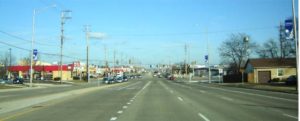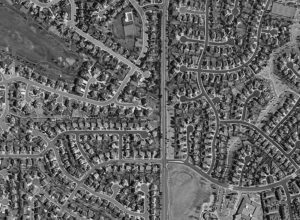More on Auto-Centric Sprawl

Unhealthy too?
These suburban views are common to many of us.


Makes me think of William Whyte’s The Organization Man (1956)
For those of you unfamiliar with Whyte’s work, he showed how big corporations of the day sought out the ideal worker who “goes along to get along” rather than anything approaching “goes against the grain.”
I thought I spotted a lot of that growing up in the suburbs of Detroit. I remember the pipe-smoking father of a classmate who took the bus to work; briefcase, Detroit Free Press edition under arm and a bland smile. He was a big-hearted guy as a Cub Scout leader, but otherwise as dull as an Organization Man. Later, I decided there could have been something therapeutic about taking the bus instead of driving. Riding the main arteries on the bus route, he was likely less spun around by those winding streets in the Levittown’s of America; but an Organization Man nonetheless.
In a recent shift from this era of auto-centric sprawl, I wrote back in November about the relocation of GE’s corporate HQ from lawnmower-bound Fairfield County to waterfront Boston.
Bringing my attention again to classic suburban development was a Washington Post article by Kathrine Shaver titled “Suburbs increasingly view their auto-centric sprawl as a health hazard.”
“Planners in Prince George’s County [MD] have talked for years about reshaping communities to help residents fetch a gallon of milk via a walk or a bicycle ride, rather than add to stifling traffic congestion by having to drive.” She then says these same planners now view low-density auto-dependent design as a health hazard as much as a traffic hazard.
“Nearly 70 percent of [PG County’s] adults are considered overweight or obese, and many areas of the county lack sidewalks or feel unsafe–whether from cars or crime–for walking, cycling or playing outside.” Okay, disadvantages of auto-centric suburbs have been observable for years. (Ever read Jane Jacob’s classic The Death and Life of Great American Cities as a counterpoint?)
The difference may increasingly be the desire to erase the current picture in many auto-centric ‘burbs in order to start suburban neighborhoods all over again with designs for human healthiness; both physical and mental. Bear in mind that in 2015 life expectancy in the U.S. declined for the first time since 1993. Think the classic suburban-development-related lifestyle may be a contributor?
As an urban dweller once again, I can’t tell you how I happily rely on my bicycle, and own two feet, to satisfy some of my needs, i.e., grocery shopping, cultural venues and sporting events, parks and a myriad of dining spots.
But, Shaver goes on to say it’s not just physical health. As well-known to subscribers to Nature Sacred or readers of its Facebook page, or, in the Baltimore area, Parks and People Foundation, open space and trees support mental health. Her article makes mention of the recent Stanford University studies reporting that “spending time in nature can boost mood and working memory while reducing brain activity related to depression.”
The Mid-Atlantic region of Kaiser Permanente has got some significant skin ($1M+) in the auto-centric game in PG County in the recent 5 years. Its focus has been 4 lower-income towns in the County. Some share of the $$ has been invested to “address barriers to healthy eating and physical activity.”
“We know we need to address the environments in which our members live, not only their health when they enter our medical centers,” said regional community health director, Celeste James.
“The Port Towns Community Health Partnership has resulted in two new urban farms, a new weekly farmers market, and classes about healthy eating and exercise in local school, [James] said.”
Unfortunately, beneficial changes from these initiatives couldn’t be bench-marked for lack of neighborhood-specific health data.
Mueller, TX, is an example of a new, 700-acre pedestrian-oriented community in Austin. Zuemei Zhu, a Texas A&M University architecture professor, conducted a pilot study there of health effects back in 2014. From her surveys, 65% of Mueller residents reported they’d become more physically active since moving there. And, 48% claimed their health had improved.
These suburban views are less common to many of us.


Meuller calls itself a sustainable transit-oriented community (aka New Urbanist). It was built on the site of an old municipal airfield. If curious, click here to go to its website to learn more about it. Also, here linked is its “Environmental Education Packet: Creating a Green Community.”
Kentlands, located in suburban Washington, DC, was a progenitor. It was pioneered in the late 1980s by developer Joseph Alfandre who hired husband-wife architects Andres Duany and Elizabeth Plater-Zyberk who were becoming known by the moniker New Urbanists. I remember getting all excited about the return of alleys for access to garages in the rear, and allowable dwelling (in-law) units above.